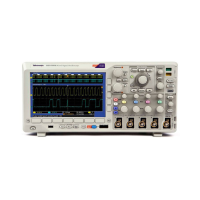Analyze Wavefor
mData
Using Math Waveforms
Create math waveforms to support the analysis of your channel and reference waveforms. By combining and transforming
source waveforms and other data into math waveforms, you can derive the data view that your application requires.
NOTE. Math waveforms are not available for use with serial buses.
Use the following procedure for executing simple (+, –, ×, ÷) math operations on two w aveforms:
1. Push Math.
2. Push Dual Wfm Math.
Dual Wfm
Math
FFT Advanced
Math
(M) Label
3. On the side menu, set the sources to either
channel 1, 2, 3, 4, or reference w aveforms
R1, R2 , R3,orR4. Choose the +, –, x,or
÷ operators.
4. For example, you might calculate power
by multiplying a voltage waveform and a
current waveform.
Quick Tips
Math waveforms can be created from channel or reference w aveforms or a combination of them.
Measurements can be taken on m ath w avefor ms in the same way as on channel waveforms.
Math waveforms derive their horizontal scale and position from the sources in their math expressions. Adjusting these
controls for the source waveforms also adjusts the math waveform.
You can zoom in on math waveforms using the inner knob of th e Pan-Zoom control. Use the outer knob for positioning
the zoomed area. (See page 118, Using Wave Inspector to Manage Long Record Length Waveforms.)
112 MSO3000 and DPO3000 Series O scilloscopes User Manual

